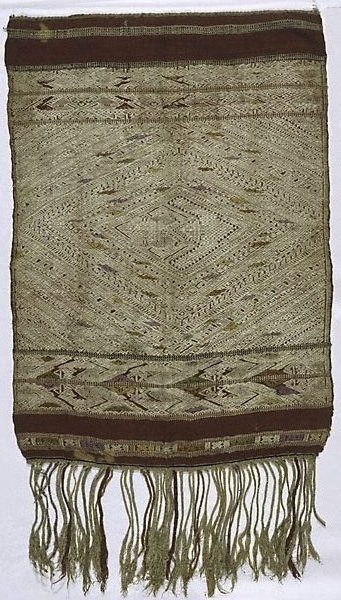-
Details
- Other Title
- End panel of a phaa biang cloth (shawl)
- Alternative title
- End panel of a 'phaa biang' cloth (shawl)
- Place where the work was made
-
Sam Nuea
→
Laos
- Cultural origin
- Tai Nuea people
- Date
- 20th century
- Media category
- Textile
- Materials used
- silk, cotton, dyes; supplementary weft weave
- Dimensions
- 38.0 x 67.0 cm
- Signature & date
Not signed. Not dated.
- Credit
- Bequest of Alex Biancardi 2000
- Location
- Not on display
- Accession number
- 284.2000
- Copyright
- © Copyright reserved
- Share
-
-
About
The Tai Neua are a sub-group of the Tai language family. The Tai live in a broad region stretching from Eastern India to Southwestern China and Northern Vietnam. Before the easy availability of printed cotton, Lao-Tai women produced all the textiles for the home, including mattresses, pillows, clothing, and decorative pieces.
This textile has red warp and weft yarns, cream continuous supplementary weft yarns, and multi-coloured discontinuous supplementary weft yarns. Cloths like this form part of a scarf made in several sections that are replaced as they wear out. These textiles have a number of functions, including as shoulder cloths (phaa phai), a cloth to wrap women's shoulders and torsos (phaa biang), head wraps (phaa khan soeng), and for healing practices (phaa sabai). Besides the central lozenge-shaped motif (kaap khoam), there are half-line hooks (dork khor), eight-pointed stars or flowers, and triangle forms, all of which are composed of supplementary weft threads. Kaap khoam means lantern. The pattern not only symbolises light, but Buddhists consider it to be the opening of the third eye bringing knowledge and enlightenment. This is probably a remnant of Mahayana and Tantric Buddhist ideas and is evidence of their earlier presence in Southeast Asia. Phaa biang are composed of several sections, and as sections become worn, they are replaced with new weavings. This is probably one such replacement.
Asian Art Department, AGNSW, December 2011
